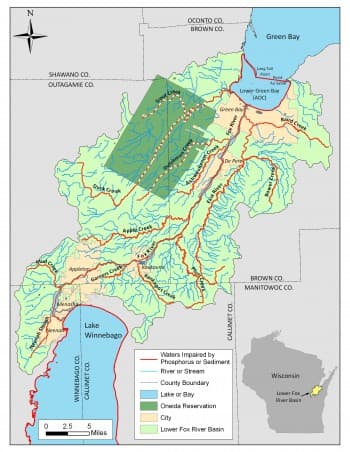TMDL Development and Implementation Planning for the Lower Fox River Basin and Lower Green Bay
Cadmus worked with Wisconsin Department of Natural Resources in the development of TMDLs for impaired water bodies
Section 303(d) of the federal Clean Water Act requires states to develop Total Maximum Daily Loads (TMDLs) for pollutants causing violation of applicable water quality standards for each impaired water body. A TMDL determines the maximum amount of pollutant that a water body is capable of assimilating while continuing to meet the existing water quality standards.
Challenge
Cadmus was retained by the U.S. Environmental Protection Agency (EPA) to provide support to the Wisconsin Department of Natural Resources (DNR) in the development of TMDLs for impaired water bodies in the Lower Fox River, including Lower Green Bay. The Lower Fox River Basin includes 34 wastewater treatment facilities, 29 Municipal Separate Storm Sewer Systems (MS4s), a tribal reservation, and significant loading from agricultural and urban nonpoint sources.
Solution
Over the course of the five-year effort, Cadmus developed 45 TMDLs for 27 segments impaired for phosphorus and sediment. The project involved:
- Data analysis.
- Numeric target development.
- Watershed modeling using the Soil & Water Assessment Tool (SWAT).
- Extensive load-allocation scenario analysis.
- Development of a customized load-allocation tool for use in calculating baseline loads and establishing the TMDLs for each of the 45 water body/pollutant combinations, including the voluntary load reduction goals for the segments on tribal land.
- Outreach component, including development of fact sheets and posters, and presentations at numerous meetings and workshops for stakeholders and the public.
We also identified potentially restorable wetlands in the Lower Fox River Basin based on the historic and current distribution of wetlands, compatible land uses, and their modeled nutrient assimilation capacity. Wetland vegetation can remove a significant amount of pollutants from the water column, especially nutrients such as phosphorus.
Results
In support of implementation planning for the TMDL, Cadmus conducted an in-depth evaluation of the effectiveness and costs associated with the implementation of the TMDL.
- Four methods were used to estimate a range of potential costs for wastewater treatment facilities to meet their respective wasteload allocations for total phosphorus.
- Potential costs for MS4s to meet their wasteload allocations were estimated using Source Loading and Management Model (SLAMM) results for each of the MS4s.
- Estimates for load reductions and costs for implementation of a select set of agricultural BMPs were obtained using the SWAT model and cost estimates developed by local experts. BMPs assessed included reduced phosphorus in animal feed, incorporation of ground-applied manure, conservation tillage, and riparian buffer strips.
As part of the implementation planning, Cadmus also conducted an analysis to identify potentially restorable wetlands in the Lower Fox River Basin based on the historic and current distribution of wetlands, compatible land uses, and their modeled nutrient assimilation capacity.
The final report is available to view or download from Wisconsin DNR’s website.
